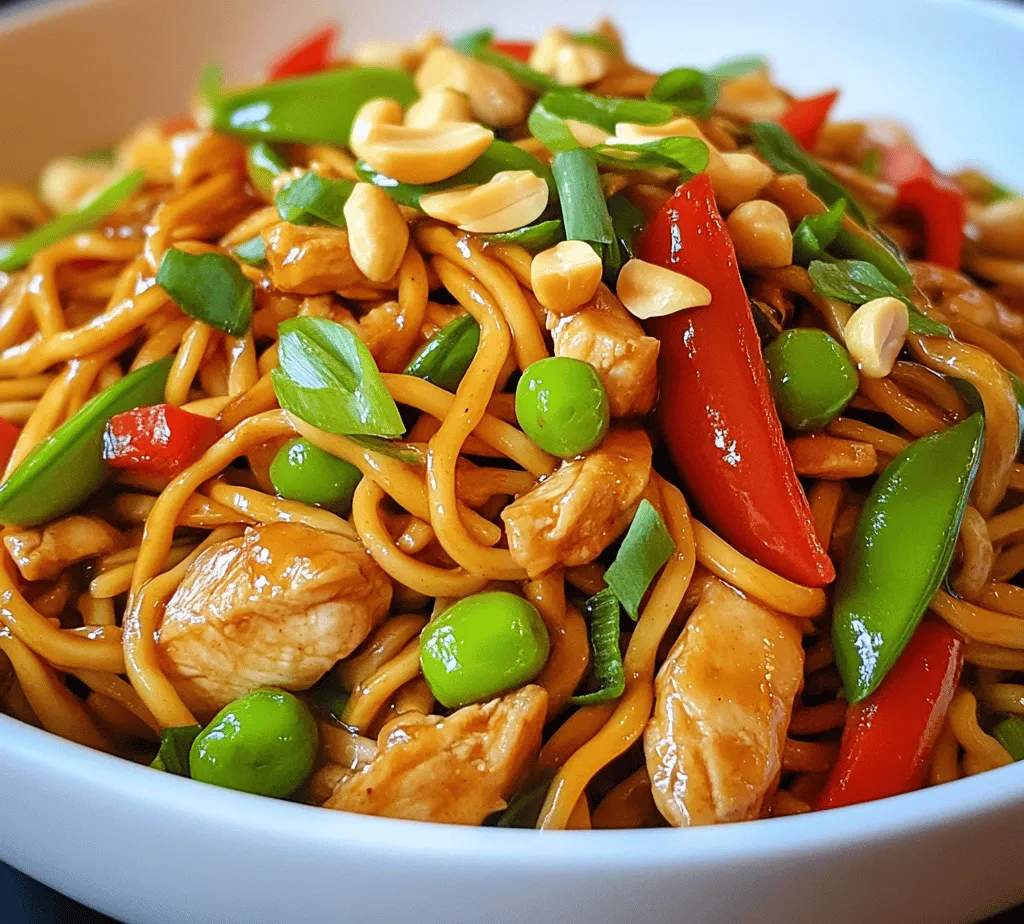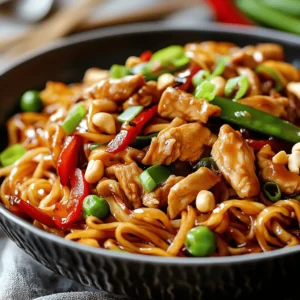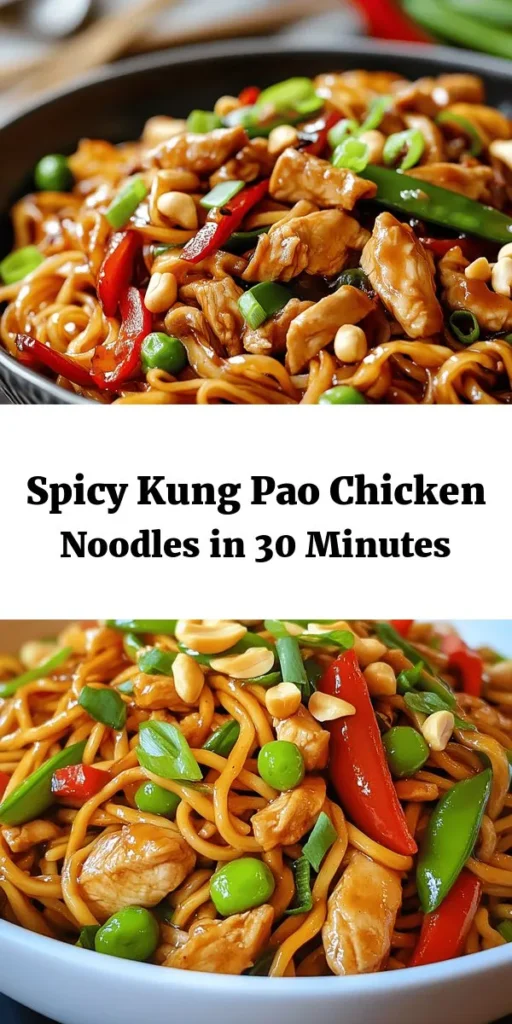Kung Pao Chicken Noodles offer a delightful fusion of flavors and textures, combining tender chicken, crisp vegetables, and savory sauces with the comforting chew of noodles. This dish, rooted in traditional Chinese cuisine, brings a spicy kick that can be adjusted to suit any palate. It’s a quick and easy recipe that is perfect for weeknight dinners or impressing guests. In this article, we will explore the origins of Kung Pao Chicken, break down the ingredients, provide a step-by-step guide, and share tips to elevate your cooking experience.
Understanding the Origins of Kung Pao Chicken
Exploring the Historical Context of Kung Pao Chicken
Kung Pao Chicken, known as “Gong Bao Ji Ding” in Mandarin, is a popular dish that hails from the Sichuan province of China. The dish is named after Ding Baozhen, a 19th-century governor of Sichuan, who was also known as “Kung Pao.” Its roots can be traced back to the late Qing Dynasty when it was primarily enjoyed by the upper class and served at banquets. Over the years, Kung Pao Chicken has evolved from a noble dish to a staple found in Chinese restaurants worldwide.
The traditional preparation involves marinating chicken in soy sauce, cooking it with peanuts and a medley of vegetables, and finishing it with a spicy sauce flavored with Sichuan peppercorns, which contribute a unique tingling sensation to the dish. Today, variations of Kung Pao Chicken can be found globally, with different regions adding their twist, including the incorporation of noodles, making this recipe a delightful adaptation that retains the essence of the classic dish while offering a new texture and experience.
The Cultural Significance of Noodles in Asian Cuisine
Noodles play a vital role in Asian cuisine, symbolizing longevity and prosperity. In many cultures, they are served at celebrations and significant life events, such as birthdays and New Year festivities. The versatility of noodles allows them to be paired with a variety of ingredients, sauces, and cooking methods, making them a beloved staple in countless dishes.
In the context of Kung Pao Chicken Noodles, the addition of noodles not only enhances the dish’s heartiness but also serves to balance the bold flavors of the chicken, peanuts, and sauce. Whether using egg noodles, rice noodles, or even whole wheat varieties, the choice of noodle can significantly influence the overall taste and texture of the dish, allowing for personal preferences and dietary restrictions to be accommodated.
How Kung Pao Chicken Evolved Over Time
As Kung Pao Chicken became more popular outside of China, it underwent various adaptations to cater to local tastes. In Western countries, the dish often features a sweeter sauce and a more diverse array of vegetables. The inclusion of noodles is a further evolution, providing a filling component that makes the dish more substantial and appealing to a wider audience.
The contemporary version of Kung Pao Chicken Noodles reflects a blend of traditional Chinese cooking techniques and modern culinary innovations. As chefs and home cooks experiment with flavors and presentation, the dish continues to evolve while retaining the core elements that make it a beloved classic.
Ingredient Breakdown: Key Components of Kung Pao Chicken Noodles
Introduction to Essential Ingredients
To create the perfect Kung Pao Chicken Noodles, it’s essential to gather fresh, high-quality ingredients that contribute to the dish’s signature flavor profile. From the protein to the vegetables and sauces, each component plays a crucial role in achieving the harmonious balance of taste and texture that characterizes this dish.
The Role of Chicken Breast in the Dish
Chicken breast is the primary protein in Kung Pao Chicken Noodles, prized for its lean quality and ability to absorb flavors well. When cooked properly, chicken breast becomes tender and juicy, providing a satisfying contrast to the crunchy vegetables and chewy noodles. For a more flavorful experience, you can marinate the chicken in a mixture of soy sauce, cornstarch, and a splash of rice vinegar before cooking. This not only enhances the taste but also helps to create a velvety texture that complements the dish.
The Importance of Fresh Vegetables: Bell Peppers and Snap Peas
Fresh vegetables are essential to creating a vibrant and colorful Kung Pao Chicken Noodles dish. Bell peppers, in particular, add a sweet crunch and a pop of color, while snap peas contribute a delightful snap and freshness. Both vegetables provide a nice contrast to the tender chicken and chewy noodles, adding layers of flavor and texture. Feel free to experiment with other vegetables, such as zucchini or carrots, depending on your preferences and what you have on hand.
A Closer Look at Noodles: Egg vs. Rice Noodles
When it comes to choosing the right noodles for your Kung Pao Chicken Noodles, both egg noodles and rice noodles are excellent options, each offering distinct qualities.
– Egg Noodles: Known for their rich flavor and chewy texture, egg noodles are made with wheat flour and eggs, making them a hearty choice. They absorb sauces well, allowing the Kung Pao sauce to cling beautifully to each strand.
– Rice Noodles: These gluten-free noodles are made from rice flour and water, offering a lighter texture that pairs well with various sauces. They are quick to cook and provide a slightly different mouthfeel, making them a great option for those seeking a gluten-free alternative.
Ultimately, the choice between egg and rice noodles comes down to personal preference and dietary restrictions. Both options will work wonderfully in this dish!
Understanding the Sauces: Soy, Oyster, Rice Vinegar, and Hoisin
The sauces used in Kung Pao Chicken Noodles are vital for creating the flavor profile that makes this dish so appealing. Here’s a breakdown of the primary sauces involved:
– Soy Sauce: A staple in Asian cooking, soy sauce provides a rich umami flavor and a salty depth that enhances the overall taste of the dish. Opt for low-sodium soy sauce if you’re looking to reduce salt intake.
– Oyster Sauce: This thick, dark sauce adds a sweet and savory flavor, deepening the dish’s complexity. It helps to create a glossy finish that makes the dish visually appealing.
– Rice Vinegar: Adding a hint of acidity, rice vinegar balances the richness of the sauces and helps to brighten the overall flavor. It also aids in tenderizing the chicken during the marination process.
– Hoisin Sauce: This sweet and slightly spicy sauce contributes a unique flavor that complements the other ingredients beautifully. A little goes a long way, so use it judiciously to avoid overpowering the dish.
The Influence of Peanuts and Spices on Flavor Profile
Peanuts are a signature ingredient in Kung Pao Chicken, providing a delightful crunch and a nutty flavor that enhances the dish. They are typically added at the end of cooking for a toasted effect, elevating the texture and taste of the final product.
In addition to peanuts, spices play a crucial role in achieving the signature heat of Kung Pao Chicken. Sichuan peppercorns are commonly used to impart a unique numbing sensation, while dried red chilies add a spicy kick. Adjusting the amount of spices allows you to customize the heat level to your preference, making this dish adaptable for all spice tolerances.
Preparation Steps: Crafting Your Kung Pao Chicken Noodles
Now that you have a solid understanding of the origins and ingredients of Kung Pao Chicken Noodles, it’s time to dive into the preparation process. Cooking this dish is straightforward and can be done in under 30 minutes, making it an excellent choice for busy weeknights.
Cooking the Noodles: Tips for Perfect Texture
1. Choose Your Noodles: Select either egg or rice noodles based on your preference. Follow the package instructions for cooking time, as different noodles may vary in preparation.
2. Boil Water: Fill a large pot with water and bring it to a rolling boil. Adding a pinch of salt can enhance the flavor of the noodles.
3. Cook the Noodles: Once the water is boiling, add the noodles and cook until they are al dente. This typically takes about 4-6 minutes for egg noodles and 3-5 minutes for rice noodles. Be sure to stir occasionally to prevent sticking.
4. Drain and Rinse: After cooking, drain the noodles in a colander and rinse them under cold water to stop the cooking process. This step is crucial, especially for rice noodles, as it helps maintain their texture and prevents them from becoming gummy.
5. Toss with Oil: To keep the noodles from sticking together, toss them with a drizzle of sesame oil or vegetable oil after rinsing. This adds a touch of flavor and ensures they stay separate during cooking.
With these steps completed, you are well on your way to crafting a delicious bowl of Kung Pao Chicken Noodles. In the next section, we will delve into the complete step-by-step cooking process, from marinating the chicken to assembling the dish for a mouthwatering final result.

Marinating the Chicken: Enhancing Flavor and Tenderness
To create a truly memorable Kung Pao Chicken Noodles dish, marinating the chicken is an essential step that enhances both flavor and tenderness. Begin by slicing boneless, skinless chicken breasts or thighs into bite-sized pieces, ensuring that they cook evenly and absorb the marinade effectively.
For the marinade, combine soy sauce, Chinese cooking wine, cornstarch, and a touch of sesame oil in a mixing bowl. The soy sauce adds depth and umami, while the cooking wine contributes a subtle sweetness. Cornstarch is crucial as it helps create a velvety texture on the chicken, preventing it from drying out during cooking. Allow the chicken to marinate for at least 30 minutes; if time permits, marinating for a few hours or overnight in the refrigerator will yield even better results.
Stir-Frying Techniques: Achieving the Perfect Sear
Stir-frying is a hallmark of Asian cooking, and mastering this technique is vital for perfecting your Kung Pao Chicken Noodles. Start by heating a wok or a large, non-stick skillet over high heat. Once the pan is hot, add a tablespoon of vegetable oil, swirling it around to coat the surface evenly.
Add the marinated chicken in a single layer, ensuring not to overcrowd the pan. Overcrowding can lead to steaming rather than searing, robbing the chicken of that essential caramelized flavor. Cook the chicken undisturbed for a couple of minutes until it develops a golden-brown crust. Then, stir-fry for an additional few minutes until cooked through. Remove the chicken from the pan and set it aside, allowing the residual heat to keep it warm while you prepare the vegetables.
Sautéing Vegetables: Balancing Texture and Flavor
With the chicken cooked, it’s time to incorporate the vibrant vegetables that will add both color and nutrition to your dish. The classic Kung Pao Chicken recipe calls for bell peppers, zucchini, and scallions, but feel free to use your favorites.
Begin by adding a little more oil to the pan, followed by minced garlic and ginger to infuse the oil with their aromatic flavors. Sauté these for about 30 seconds until fragrant, being careful not to burn them. Next, add the vegetables, starting with the ones that take longer to cook, such as bell peppers and carrots, and finish with quicker-cooking vegetables like zucchini and scallions. Stir-fry the vegetables for about 3-5 minutes, maintaining a crisp texture by keeping the heat high and stirring constantly.
Combining Ingredients: Ensuring Even Distribution of Flavors
Once the vegetables are tender-crisp, it’s time to bring everything together. Return the cooked chicken to the pan and pour in a mixture of soy sauce, rice vinegar, sugar, and Sichuan peppercorns to create that signature Kung Pao sauce. This sauce is what elevates the dish, providing a perfect balance of salty, sweet, and tangy flavors.
Stir everything together, ensuring that the sauce evenly coats the chicken and vegetables. Allow the mixture to simmer for a few minutes, letting the flavors meld together. If you prefer a thicker sauce, you can add a slurry of cornstarch and water at this stage, stirring until the sauce reaches your desired consistency.
Garnishing for Presentation: The Finishing Touch
Presentation plays a crucial role in Asian cuisine, and Kung Pao Chicken Noodles are no exception. Once your dish is cooked to perfection, it’s time to garnish. Sprinkle chopped roasted peanuts over the chicken and vegetables for a delightful crunch that complements the tender textures of the noodles and protein.
Additionally, add freshly chopped scallions and a sprinkle of sesame seeds for a pop of color and flavor. These garnishes not only enhance the visual appeal of your dish but also contribute layers of taste that will elevate your Kung Pao Chicken Noodles to the next level.
Nutritional Profile: Health Benefits of Kung Pao Chicken Noodles
Analyzing the Nutritional Value of Ingredients
Kung Pao Chicken Noodles are more than just a delicious meal; they also offer several nutritional benefits, making them a great choice for a balanced diet. The primary ingredients in this dish—chicken, vegetables, and noodles—provide a variety of essential nutrients.
Chicken is a high-quality source of protein, which is vital for muscle repair and growth. Vegetables such as bell peppers and zucchini are rich in vitamins A and C, which are crucial for immune health and skin maintenance. Noodles, depending on the type used, can be a source of carbohydrates that provide energy for daily activities.
Health Benefits of Chicken and Vegetables
The health benefits of Kung Pao Chicken Noodles extend beyond basic nutrition. The inclusion of chicken in your diet supports weight management, as it helps keep you satiated longer. The vegetables offer dietary fiber, which aids digestion and promotes a healthy gut.
Furthermore, the use of peanuts provides healthy fats and protein, contributing to heart health. The spices used in Kung Pao, such as ginger and garlic, have anti-inflammatory properties and can boost your metabolism, making this dish not only tasty but also beneficial for your overall health.
Balancing Flavor and Nutrition in Asian Cuisine
One of the hallmarks of Asian cuisine, particularly in dishes like Kung Pao Chicken Noodles, is the ability to balance flavor and nutrition. This dish incorporates a variety of textures and tastes, from the crunch of vegetables to the savory richness of the chicken, all while being mindful of health.
By using quality ingredients and balancing the preparation methods, you can enjoy a meal that satisfies cravings while nourishing your body. This is a perfect example of how Asian cuisine can be both indulgent and health-conscious.
Variations and Customizations: Making It Your Own
Exploring Vegetarian and Vegan Options
For those looking to enjoy a meat-free version of Kung Pao Chicken Noodles, there are plenty of options available. Tofu serves as an excellent substitute for chicken, providing similar protein content while absorbing the flavors of the marinade and sauce beautifully.
You can also explore other plant-based proteins such as tempeh or seitan, which can add unique textures and flavors to the dish. Ensure to marinate these alternatives just like you would with chicken to maximize their taste.
Adjusting Spice Level: Tailoring to Your Taste
The iconic spiciness of Kung Pao Chicken Noodles can be adjusted to suit your palate. If you prefer a milder dish, reduce the amount of dried red chilies or omit them entirely. Alternatively, for those who crave heat, you can add extra chilies or even a dash of chili oil to enhance the spiciness.
Substituting Ingredients for Dietary Restrictions
Kung Pao Chicken Noodles can easily be adapted for various dietary restrictions. For gluten-free options, choose gluten-free soy sauce and noodles made from rice or other gluten-free grains.
If you’re looking to lower the carbohydrate content, consider using shirataki noodles or spiralized vegetables as a substitute for traditional noodles. These alternatives will allow you to enjoy the dish while staying within your dietary preferences.
Creative Twists: Adding Different Proteins or Vegetables
The beauty of Kung Pao Chicken Noodles lies in its versatility. Feel free to experiment with different proteins such as shrimp, beef, or even a combination of different proteins for a unique twist.
In terms of vegetables, consider incorporating snap peas, broccoli, or even mushrooms for added depth and nutrition. The combination of flavors and textures can be tailored to your preferences, making every preparation a new experience.
Conclusion: Enjoying Your Homemade Kung Pao Chicken Noodles
In conclusion, Kung Pao Chicken Noodles is a versatile and flavorful dish that captures the essence of Chinese cuisine while allowing for personal adaptations. With its combination of savory and spicy elements, this recipe not only satisfies the taste buds but also encourages culinary creativity.
Whether you stick to the traditional recipe or explore variations, Kung Pao Chicken Noodles are sure to become a beloved staple in your home cooking repertoire. Enjoy the process of making this dish, and savor the delicious results. The balance of flavor and nutrition, combined with the ability to customize the dish to suit your preferences, makes Kung Pao Chicken Noodles a delightful option for any meal.



